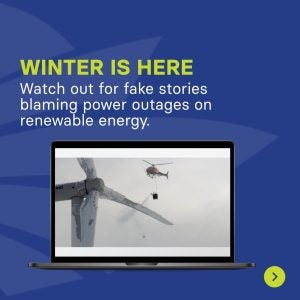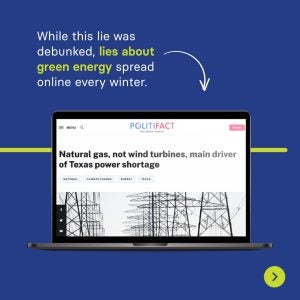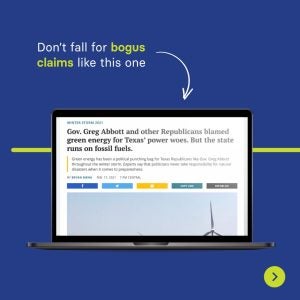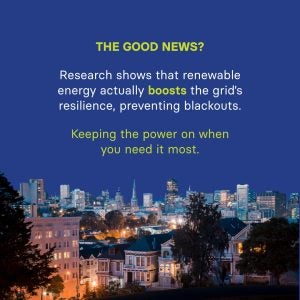The power grid and disinformation
 Texans know better than to believe the lies. But, whenever severe weather strikes the state and the isolated electric grid is imperiled, they’re always fed them: “Green energy” is offered up as the ultimate scapegoat, facts be damned.
Texans know better than to believe the lies. But, whenever severe weather strikes the state and the isolated electric grid is imperiled, they’re always fed them: “Green energy” is offered up as the ultimate scapegoat, facts be damned.
Why doesn’t the Wall Street Journal editorial board know better? Last week, they ran a piece blaming federal climate policy and “force-fed green energy” for threats to the grid during December’s cold weather emergency.
It was the exact same lie Texans heard when Winter Storm Uri devastated our state in 2021, when temperatures plummeted below freezing after days of colder weather and growing concerns about the grid. In the aftermath of that storm, Texas politicians were desperate to determine who was responsible — or at least to cast blame away from themselves. One early talking point emerged. While the ground was still frozen and millions were still without electricity or clean water, Gov. Greg Abbott appeared on cable television to blame the collapse on frozen wind turbines, contradicting his own utility experts.
The Electric Reliability Council of Texas, or ECROT, the state agency responsible for the grid, said wind and solar were always expected to make up a smaller share of grid capacity during the winter — and yet, in the case of solar, overperformed projections during Winter Storm Uri. In fact, extremely poor performance from fossil power plants and their fuel supply was the driving force plunging our state into multiple days of cold and darkness and causing hundreds of deaths.
Here is what really happened in Texas: When the temperatures dropped, multiple gas and coal power plants, representing 30,000 megawatts of power, went offline due to frozen equipment, causing outages across the state. Gas production in the state dropped 85% as many natural gas operators, having failed to sign up for the state’s “critical infrastructure designation”, either lost power and couldn’t operate or experienced their own problems with frozen equipment due to inadequate weatherization. Without their expected supply of natural gas, more plants were forced offline, creating more widespread outages. Coupled with skyrocketing demand from poorly insulated and inefficiently heated homes, it’s no surprise the grid began to falter. Wash, rinse, repeat — until millions of Texas were left without electricity.
Uri was a uniquely powerful storm but fossil fuel’s performance problems during extreme weather continues. The most recent cold snap (not as bad as Uri) also shows the vulnerability of fossil fuel power and its supply. On Dec. 23, ERCOT’s new CEO, Pablo Vegas was forced to ask the U.S. Department of Energy for special “permission to pollute” as the state lost 12,500 megawatts of gas and coal power and was facing imminent reliability problems.
If you’re inclined to think building new gas plants will solve the problem, 10 brand new gas power plants built last year were part of the most recent power failures. And this isn’t unique to Texas. Duke Energy in North Carolina admitted that their recent holiday power woes were largely due to losing 2,500 megawatts of gas power.
And here’s the truth about what renewable energy is delivering in Texas. Every single month, clean energy is powering our homes and businesses with emission free electricity while saving Texans almost $1 billion on their electricity bills. Every month.
That eye-popping figure, the headline from a study released last month doesn’t even count all of the additional resources that are about to come online across the state due to recent federal infrastructure and climate legislation. Nor does it include the wealth of solar, wind and storage projects that are queuing up to plug into Texas’ grid. It underscores the essential and fast-growing role that clean energy plays in helping to keep Texans’ lights on and to lower electricity bills.
In Texas, the capital markets see the future. Looking at ERCOT’s list of what power generation supplies are slated to come online (what capital markets want to fund in other words) solar leads the pack with battery storage and additional wind power next in line. Why? It’s cheap, clean and reliable.
Yes, the wind doesn’t always blow, and the sun doesn’t always shine. As our state and national power grids continue to decarbonize and add more renewable power we will need clean, flexible, dispatchable resources to fill the gaps. Natural gas has a strong role to play for now but also utility scale battery storage, which is poised for massive growth (as reported by the Wall Street Journal), and demand side solutions such as home solar with batteries. Newer technologies like next-generation geothermal, hydrogen, or perhaps small scale nuclear are also predicted to be part of a clean, future power grid.
As the country continues to face weather emergencies worsened by the climate crisis, we cannot afford to let disinformation stand in the way of real fixes to our aging infrastructure and the inevitability of a carbon-free electric grid with renewable power as its backbone.













